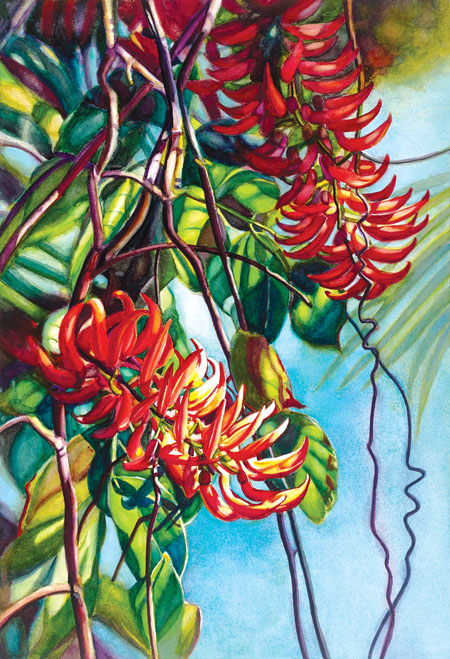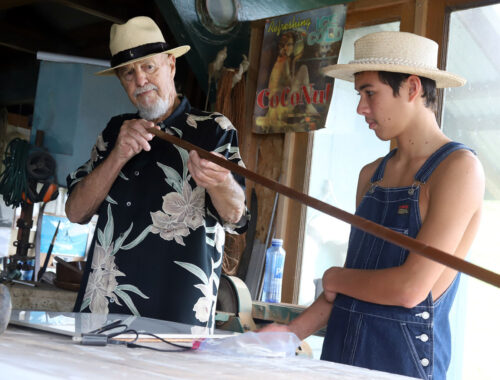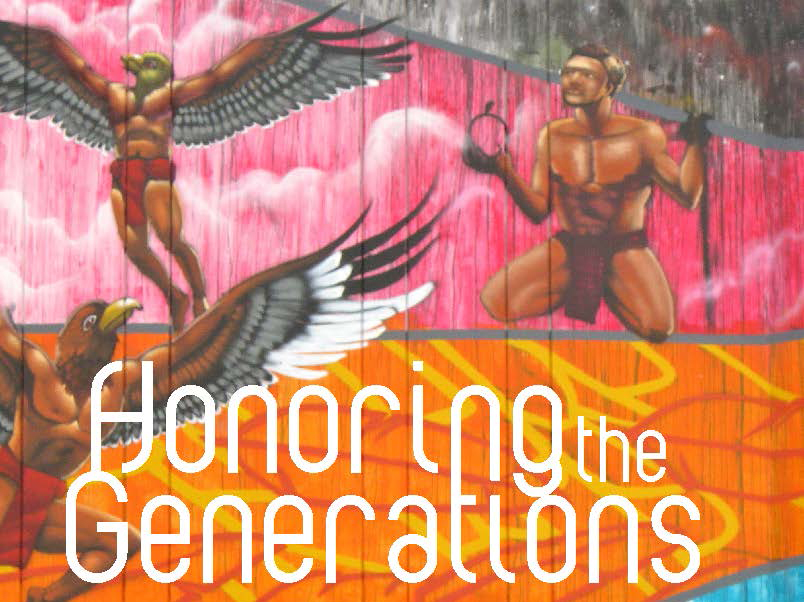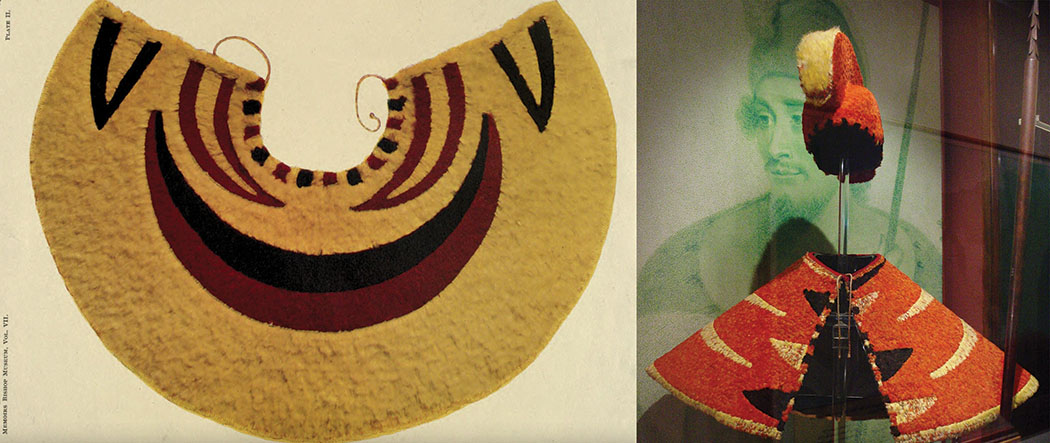
Feather Art: Yesterday, Today, and Tomorrow

By Barbara Fahs
Na lima mili hulu no‘eau is a Hawaiian expression that means “the skilled hands that touch the feathers.” It honors the ancient art of feather lei, capes, headdresses, and other ornaments. In today’s world, it can easily be extended to include other forms of feather art that might not be strictly Hawaiian and yet, which still reflect a strong Hawaiian influence.
History and Evolution of Feathers in Art
Flower lei are a cultural icon of Hawai‘i that most visitors have probably experienced. The early Polynesians introduced them to our islands in prehistory. These lovely ornaments represent welcome, protection, and mercy.
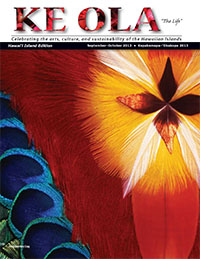
Feather lei, capes, and other decorative pieces are not as widely known. They date back to antiquity in many of the Polynesian cultures that predate Hawai‘i.
The Maoris in New Zealand made capes from their native birds’ feathers.
In what is now known as French Polynesia, Tahitian peoples of a former era made feather ornaments, and Marquesans made headdresses.
It is from these latter parts of Polynesia that the ancient voyagers embarked on their journeys of discovery that led to the birth of the Hawaiian people and their culture.
Although the feather work in other parts of Polynesia was intricate and beautiful in its way, “nowhere do we find such an intricate and highly developed technique of feather work as we do in Hawai‘i,” according to the State Council on Hawaiian Heritage.
Restricted to ali‘i, or royalty, in accordance with the ancient system of kapu that ruled early Hawaiians, only men were allowed to make feather garments and ornaments. Feather cloaks, lei, and other pieces were relatively rare because the feathers could be difficult to acquire. Special feather collectors existed in ancient villages whose life work was to collect feathers from native birds.

One of the methods of humanely trapping birds was to use a sticky substance called birdlime. The feather collector smeared it on tree branches where birds such as the now-extinct ‘ō‘ō were known to exist. After a bird became stuck in the lime, the collector plucked the feathers he wanted, cleaned the bird’s feet, and then set it free. Some birds, such as the ‘ō‘ō, had only six prized yellow feathers, which made the task of collecting a sufficient number arduous and lengthy.
The classic example of ancient feather work is the cape worn by King Kamehameha I (pictured above), which contains millions of small red and gold feathers. It is said that featherworkers spent more than two generations making this astounding piece and that Kamehameha had not yet been born when they began working on it.
Nowadays, feather artists do not capture birds to obtain the feathers they need for their work. Instead, they purchase them. Many common bird feathers will suffice: common birds, such as chickens, pheasants, doves, ducks, and canaries supply today’s feathers. Sometimes feathers are dyed brilliant colors.
Laws and restrictions exist that dictate which birds’ feathers may be used: raptors, even those that have been found dead, such as owls or hawks, are not allowed.

Kumu Aunty Doreen Henderson Creates a New Generation of Feather Artists
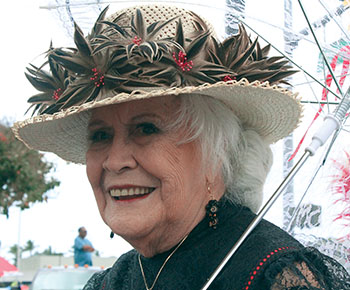
Aunty Doreen Henderson’s life revolves around keeping the tradition of feather lei alive. At 88 years young, she is a vibrant bundle of energy who wants to live to be 125 so she can continue to teach how to make these lovely lei. With five classes each week, “I don’t have time to eat!” Doreen joked.
“I knew about feather lei as early as age 12. My uncle was a lima lei hulu, and he would pay my sister and me to gather the feathers from his canaries. The work was a bit too tedious for us as children, so it wasn’t until I met Master Kumu Mary Kahihilani Kovitch, a student of Mary Lou Kekuewa, that I became a student and fell in love with feather work,” she shared.
Doreen served as the very first queen, or mō‘ī wahine of the Merrie Monarch Festival in 1963. In 1988, she returned to Hawai‘i Island from California to appear in the 25th Merrie Monarch Festival, and in 1991 she moved back to her home island. This year, we were honored by her appearance at the 50th Merrie Monarch Festival in April. Doreen rode in the parade behind the royal float and was also honored by Hawaiian Airlines.She wore a feathered wristlet she received from one of her students, a collar she fashioned this year from peacock feathers specifically for the dress she wore, and a peacock hairpiece she saved from the first Merrie Monarch Festival.
Aunty Doreen explained, “I learn something different every day from my students and many of them are actively making feather work and selling lei. I love that once they get started making these beautiful lei they don’t ever want to stop.”
“We have a class at the Kea‘au Senior Center on Wednesdays, and for younger students we meet at my nearby home two nights a week. I also teach in Pāhoa and on Friday and Saturday I travel to Hawaiian clubs and hālau. I don’t have time to make many lei anymore, but I love teaching,” Doreen concluded.
Feather Art Today: Beth McCormick Takes the Art To a New Level
Beth McCormick has made her career from the feather art she began creating 30 years ago.
“I started working with feathers when I was an art student at the University of Hawai‘i at Mānoa, and I am mostly self-taught,” she shared. “I needed work and found an ad in the local newspaper for a feather worker. Since I had been a potter and was interested in all forms of art, I started making necklaces, earrings, hair combs, and other feathered wearables.”
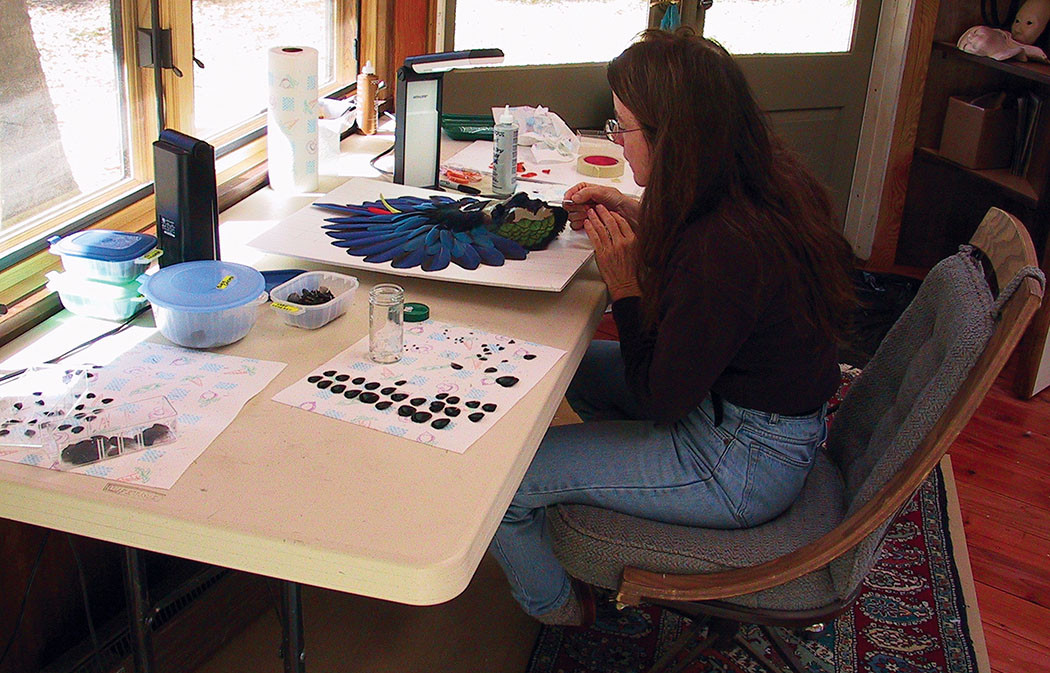
“Every artist wants to find that piece of fresh turf that is uniquely their own,” she continued. “And it turned out that feathers were mine. I took inspiration from ancient Hawaiian culture, tribal cultures from around the world, tai chi, and meditation.”
Delving into the creation of three-dimensional shields and masks of faces she fashions from media such as porcelain and cold-cast bronze, McCormick combines feathers with sculpture.
“I use parrot and macaw feathers, which were collected when the birds shed, or molted. Many people have gathered feathers for me. I prefer to use only naturally-occurring colors and avoid dyed feathers.”
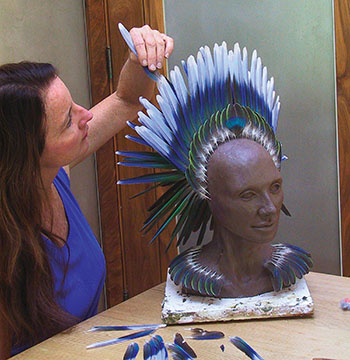
A lovely example of feathers she received as a gift is represented in her work entitled “Dreaming a Different World.” It contains the perfectly matched tail feathers of an Australian Rosella as its headdress. A friend of Beth’s, who patiently collected feathers for 11 years and then sent them to the artist, owns the bird, named “Loki.” Beth expressed her amazement and joy by saying, “Where would anyone find such a perfect collection of feathers—more than a hundred tail feathers from one fairly small bird? I knew I had to make a special piece with these feathers.”
Evoking the “appearance of artifacts from an obscure civilization that never actually existed,” according to her website, McCormick’s feathered shields and sculpted porcelain masks have contributed to a new genre, a new artistic medium.
Her artwork has been shown in more than 90 galleries nationwide and abroad. It is in many private collections, including the Michael Rosenberg Collection in London, and the Chris Hemmeter Collection in Hawai‘i.
“The Gallery of Great Things in Waimea has some of my pieces here on Hawai‘i Island,” McCormick added.
“I want to encourage young artists to have the courage to take a traditional craft like this into a new dimension. It is possible to make a living from your art—you just need that fresh turf, something different, something that no one else has done before.”
Enjoy Feather Art In Person
Hulihe‘e Palace
A feather kīpuka (short shoulder cape) and kāhili (feather standard, symbolic of royalty) can be found at the Hulihe‘e Palace in Kailua-Kona.
Lyman Museum
Hilo’s Lyman Museum holds an annual feather lei exhibit every May for two to four weeks, in conjunction with the Merrie Monarch Festival. During that time, Aunty Doreen Henderson holds court every day to teach and demonstrate her master art form.
“Aunty is still experimental—she still has ‘it,’ and her mission is to keep the art form alive,” said Jeff Flox, Lyman Museum’s exhibit manager. “Hers is a living art, and although she bases her designs on the past, she always pushes the envelope. I think that’s one of the main reasons she attracts so many students.” ❖
Mele Inoa Ali‘i, after Kuluwaimaka
From the Master Chanters of Hawai‘i Collection
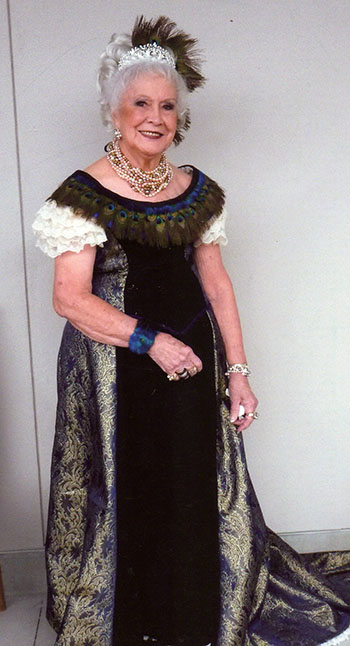
‘Ike ia Kaukini he lawai‘a manu
He ‘upena ku‘u i ka noe ko Pokahi
Ke ho‘opuni la i ka ‘ohu
Ke ho‘opuni la i ka ‘ohu na kikepa
Ke na‘i i ka luna o Ka‘auana
‘O ka ‘uahi ke kapeku
E hei ‘ai ka i‘a manu o Puoali‘i
‘O ke ali‘i wale no ka‘u makemake
‘O ka luhi o maua me ‘ia nei
‘O ka makou le‘ale‘a no ‘ia
You will recognize Kaukini, the bird catcher
Spreading his nets like the mist of Pokahi
The mist stretches
Stretching the mist-like nets around
And over the uplands of Ka‘auana
The dark smoke will drive
The bird Puoali‘i into the net
I delight in serving the chief
Whom I and others care for
This is our joy
For more information:
Hulihe‘e Palace: HuliheePalace.net
Lyman Museum: LymanMuseum.org
Contact Doreen Henderson: 808.982.5571
Contact Beth McCormick: OnionHouseHawaii.com
Contact writer Barbara Fahs: hiiakas@lava.net
